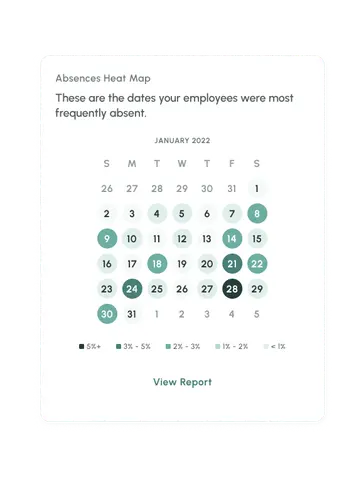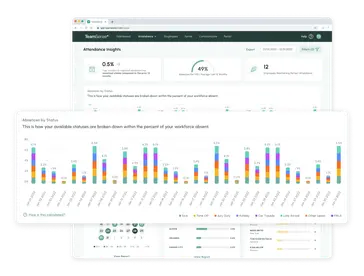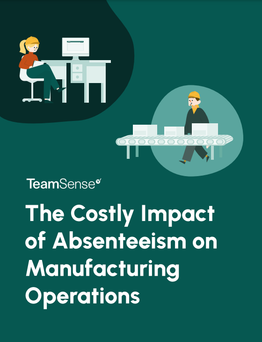Fix the root cause of No-Call No-Show with help from TeamSense
You might think having a crystal ball would be handy for predicting employee attendance, but we've got something even better—hard data. Diving into attendance records and data insights is like having your very own backstage pass to understanding the patterns and quirks of your workforce. We're not just talking about spotting who’s consistently late (though that’s part of it); it’s about zooming out to see the bigger picture.
Think of it this way: if you could predict high-absence days like the Monday after the Super Bowl, when an estimated 16 million people called out in 2024, how much easier would managing shifts and planning labor become? Attendance data doesn't just help you play detective on individual cases—it allows you to strategize company-wide, adapt your policies, and be proactive with employee improvement plans. In this blog, we'll dig into how you can use attendance records to not only keep the ship steady but also navigate your team toward smoother sailing.
TL;DR Summary
- Leverage Attendance Data: Use detailed data to spot patterns in absenteeism, whether it's a single employee frequently calling in on Mondays or company-wide trends around events like the Super Bowl.
- Proactive Interventions: Utilize attendance data to create targeted improvement plans and offer support early, addressing issues before they escalate.
- Improve Labor Planning: Optimize your workforce allocation by predicting high absenteeism periods and ensuring critical shifts are covered, minimizing disruptions.
- Enhance Policies and Culture: Adjust attendance policies using data to ensure they're effective and fair. Recognize employees with strong attendance to foster a positive culture.
- Choose the Right Tools: Implement an attendance tracking system like TeamSense to gain real-time insights and make informed, data-driven decisions.
- Turn Insights into Action: Regularly review data to create actionable strategies, measure the impact, and celebrate improvements to keep the momentum going.
The Power of Attendance Data
Let’s break down why attendance data is like having a backstage pass to understanding what’s really going on with your team. Sure, it goes way beyond just tracking who punched in or who called out sick. It’s like turning the lights on in a room where you’ve been stumbling around in the dark.
By digging into attendance patterns, you can uncover all sorts of trends. Maybe you notice a spike in absences on certain days, or during specific times of the year. For example, you might find an odd pattern on a day after a holiday or big event—something a lot of companies deal with. If you’re prepared, you can plan for those days in advance, making sure you’re not caught off guard.
Attendance data also helps you get ahead of individual issues. Spotting an employee who’s starting to show a pattern of being late or taking a lot of unplanned days off gives you the chance to step in early. Maybe there's something going on that you can help with, or maybe they just need a gentle reminder about the attendance policy. Either way, you're showing that you're proactive and that you care about their well-being.
On a bigger scale, this data gives you a clear picture of what’s happening company-wide. You can see if there are departments or shifts with higher absenteeism and figure out if there are underlying issues to address. Are your night shifts consistently understaffed? Is there a particular season when absences spike? Is there a manager who's shift is always low on staff? By getting ahead of these trends, you can make smarter decisions about scheduling and resource allocation, keeping your team running smoothly.

Identifying Attendance Trends
Spotting patterns in attendance is like having a roadmap to understand what's really going on with your team. When you start diving into the data, you'll notice two main types of trends: individual and company-wide. Each offers valuable insights that can help you take proactive steps in managing attendance more effectively.
Spotting Patterns in Employee Absenteeism
Individual Trends
When you look at attendance data for individual employees, certain patterns might start to pop up. For example, you might notice an employee who frequently calls out on Mondays or Fridays. It could be a sign of burnout, a lack of engagement, or maybe even an underlying personal issue. By catching these patterns early, you can have a conversation with the employee and find out if there's something going on that you can help with—whether that’s adjusting their workload, offering support, or just understanding their situation better.
Company-Wide Patterns
Zoom out a bit, and attendance data can reveal trends affecting your entire workforce. Maybe there's a noticeable spike in absences on the day after a big company event, or perhaps the days leading up to a holiday weekend always have a higher-than-normal reported number of callouts. For example, the Monday after the Super Bowl in 2024 saw an estimated 16 million people call out of work. If you notice your team tends to follow this trend, you can plan ahead, either by scheduling fewer critical tasks around that time or by offering flexible scheduling options to accommodate.
Seasonal and Event-Based Trends
Preparing for High Absenteeism Periods
Seasonal trends are another biggie. Every workplace has those times of year when absences tend to spike—flu season, summer vacations, or around the holidays. With solid attendance data, you can predict these periods and plan accordingly. Maybe it's about bringing in temporary staff, adjusting shifts, or even offering wellness programs to help mitigate the impact of sick leave. The key is using the data to anticipate and adapt rather than being caught off guard.
Real-World Example
Let's go back to that Super Bowl example for a second. Knowing that the Monday after is a day when many employees might call out, you can strategize. It could mean arranging coverage in advance, allowing flexible start times, more hours or even planning a team-building activity to re-engage employees who do come in. This kind of foresight, powered by attendance data, helps you stay ahead of the game and keeps your operation running smoothly, even when the unexpected happens.
By identifying both individual and company-wide trends, you can get a clear picture of what's happening and take actionable steps to improve overall attendance. It's all about being proactive, using the data you have to create a more supportive, flexible, and efficient workplace.

Using Attendance Data for Proactive Management
Getting ahead of attendance issues before they snowball is where data really shines. Instead of reacting to problems after they've already caused disruptions, you can use data insights to take proactive steps in managing your workforce more effectively.
Crafting Employee Attendance Improvement Plans
Early Intervention
Attendance data can be like an early warning system for potential issues. If you notice an employee starting to show a pattern of frequent absences, it's a signal that they might need some support. Maybe they're dealing with personal challenges, health issues, or simply feeling disengaged at work. Whatever the reason, having this data at your fingertips allows you to step in early, offering a supportive conversation or resources before it becomes a bigger problem.
Tailored Solutions
One-size-fits-all solutions rarely work when it comes to attendance issues. By analyzing attendance data, you can get to the root of what's causing the problem for each individual. Is it always Mondays or the day after a shift change? This information helps you craft a personalized attendance improvement plan that addresses the specific reasons behind their absences. Maybe it's flexible scheduling, offering additional support, or connecting them with resources like employee assistance programs. Tailoring your approach shows employees that you're not just handing out generic solutions but are genuinely invested in helping them succeed.
Enhancing Labor Planning and Scheduling
Optimizing Workforce Allocation
Attendance data isn't just about flagging issues—it's a goldmine for optimizing your workforce. By understanding attendance patterns, you can plan shifts more effectively and allocate resources where they're needed most. For instance, if you notice that certain days or times consistently have higher absenteeism, you can adjust your scheduling to ensure you have the right coverage. This way, you're not just filling shifts randomly but aligning your workforce with the actual demand, reducing the risk of being understaffed during critical periods.
Minimizing Disruptions
Armed with attendance insights, you can take steps to minimize disruptions before they even happen. If you know in advance that certain times of the year see a spike in absences, like during flu season or after major events, you can plan ahead. This might mean cross-training employees for critical roles, setting up a pool of on-call staff, or even temporarily increasing your workforce. The goal is to ensure that key roles are always covered, keeping operations running smoothly and maintaining productivity even when absences are higher than usual.
By using attendance data proactively, you're not just reacting to problems; you're anticipating and addressing them before they impact your team or operations. It’s all about being strategic, using the insights you gather to create a work environment that's not only efficient but also supportive and responsive to the needs of your employees.

The Costly Impact of Absenteeism on Manufacturing Operations
Learn how chronic, unplanned absenteeism is a costly impediment to manufacturing productivity and efficiency, and how you can reduce absenteeism.
Enhancing Company Policies and Culture Through Data
Attendance data isn't just about tracking who shows up; it's a tool that can shape and refine your company’s policies and culture. When used effectively, it can lead to a workplace that not only runs more smoothly but also feels fairer and more engaging for everyone present.
Data-Driven Policy Adjustments
Reviewing and Updating Policies
Regularly reviewing attendance data gives you the insights needed to evaluate how well your current attendance policies are working. Are they too strict, leading to resentment? Or maybe too lenient, allowing issues to slip through the cracks? With clear data at hand, you can make informed adjustments that reflect the real-world needs and behaviors of your workforce. This isn’t about being punitive; it’s about creating policies that are realistic and effective, aligning with what you see happening on the ground.
Transparency and Fairness
When your policies are backed by data, it’s easier to maintain transparency and fairness in the workplace. Employees are more likely to trust and adhere to attendance guidelines if they know those rules are based on factual, company-wide trends rather than arbitrary decisions. Plus, having data-driven policies means you can provide clear, objective evidence when addressing attendance issues, reducing the risk of misunderstandings or perceived bias. It fosters a workplace where everyone knows what to expect and what’s expected of them.
Fostering a Positive Attendance Culture
Encouraging Engagement
Attendance data can also be used as a tool for positive reinforcement. By recognizing and rewarding employees who consistently have strong attendance records, you can foster a culture that values and celebrates reliability. This could be as simple as acknowledging these employees in team meetings or implementing a reward system where consistent attendance earns perks or bonuses. When employees see that their efforts to show up and contribute are noticed and appreciated, it boosts morale and encourages a sense of accountability across the board.
Employee Feedback
Your attendance data can be even more powerful when combined with employee feedback. If you notice a trend in absenteeism, it could be a sign that something in the workplace environment needs addressing. Perhaps there's an issue with scheduling, work-life balance, or even the company culture itself. Engaging with employees directly to understand the ‘why’ behind the data allows you to make meaningful changes that improve overall satisfaction and, in turn, attendance. It’s about creating a dialogue where data informs your questions and employee feedback guides your solutions, leading to a more positive, inclusive workplace.
By leveraging attendance data not just as a monitoring tool but as a means to enhance your company’s policies and culture, you're building a more engaged and resilient team. It’s all about using the insights you have to create a workplace where everyone knows the rules, feels valued, and wants to be a part of the success.

Tools and Technology for Tracking Attendance Data
When it comes to tracking attendance data, the right tools can make all the difference. Not only do they simplify the process of recording attendance, but they also offer valuable insights that can help you manage your team more effectively.
Choosing the Right Attendance Tracking System
Features to Look For
Selecting an attendance tracking system isn't just about finding something that clocks in and out times; it's about finding a tool that offers a comprehensive view of employee attendance. Look for features like real-time tracking to get instant updates on who's in and who's out, which is particularly handy for large teams or multiple locations. Reporting and analytics are crucial as well—they turn raw attendance data into actionable insights, showing you patterns and trends over time. Other useful features might include integration capabilities with other HR software, user-friendly interfaces to ensure easy adoption by your team, and mobile accessibility so employees can check in or report absences from anywhere.
Implementing the Right Tools
Integrating a new attendance tracking system into your existing workflow doesn’t have to be a headache. Start by identifying your company’s specific needs—are you looking for better insights, more accurate tracking, or an easier way for employees to report absences? Once you know what you need, choose a system that fits seamlessly with your current processes and is scalable for future growth. Look for systems that offer integration with your existing HR software and provide training and support during the implementation phase. This ensures a smooth transition and helps your team get up to speed quickly.
Leveraging TeamSense for Insightful Attendance Data
Overview of TeamSense
TeamSense takes attendance tracking to the next level by providing detailed data and analytics that help companies identify trends and make informed decisions. Unlike traditional systems, TeamSense offers real-time updates and automated absence reporting, giving managers immediate visibility into staffing changes. Its intuitive dashboard allows you to track attendance patterns, identify potential issues early on, and create personalized attendance improvement plans for individual employees. The system is designed to be mobile-friendly and user-centric, making it easy for employees to report absences and check their attendance status, which encourages transparency and accountability.
Benefits of Data-Driven Decisions
Using TeamSense’s data insights, companies can move from a reactive approach to a proactive stance on attendance management. For instance, with detailed analytics, you can spot trends like frequent absences on specific days of the week or during certain times of the year, enabling you to plan better and allocate resources more efficiently. If you notice an employee's attendance pattern changing, you can intervene early, providing support or implementing an improvement plan before it becomes a bigger issue. The ability to integrate attendance data with other HR tools means you can streamline your processes, from payroll to compliance, all while maintaining accurate, up-to-date records.
Incorporating tools like TeamSense not only simplifies attendance tracking but also gives you the insights needed to foster a more reliable and engaged workforce. By making data-driven decisions, you can address attendance issues more effectively, improve labor planning, and ultimately create a workplace where everyone is motivated to show up and contribute.
Turning Data into Action
Gathering attendance data is only half the battle. The real game-changer comes when you turn that data into actionable strategies that drive improvement. This section covers how to create a plan based on insights and how to measure your progress effectively.
Creating an Actionable Plan
Data-Driven Strategies
It's one thing to have a mountain of attendance data and another to know what to do with it. Start by analyzing the data to identify key trends and patterns. Are there specific days when absenteeism spikes? Do certain departments have higher absence rates? Use these insights to develop targeted strategies. For example, if you notice a lot of absences on Mondays, you might consider introducing flexible start times or implementing an employee engagement activity to boost morale. The key is to create strategies that directly address the trends you're seeing.
Once you've identified the areas that need improvement, set clear, measurable goals. This could be anything from reducing overall absenteeism by a certain percentage to improving attendance in a specific department. The strategies you develop should be specific and actionable, with a focus on both short-term fixes and long-term improvements.
Continuous Improvement
Remember, this isn't a one-and-done deal. To keep attendance on the upswing, you need to regularly review the data and adjust your strategies as needed. Schedule routine check-ins to assess how your plan is working. Are you seeing the desired improvements, or do you need to tweak your approach? Continuous improvement is key here—using data to refine your strategies ensures that you're not just putting a band-aid on the problem but actually working toward lasting change.
Measuring Success
Tracking Progress
To know if your strategies are hitting the mark, it's crucial to have a way to track progress. Use your attendance data to measure the impact of the changes you've implemented. Are absenteeism rates dropping? Are employees more consistent in their attendance? Track these metrics over time to see how your efforts are paying off. It's not just about the numbers, though—look for qualitative changes too, like improved team morale or better engagement during shifts.
Celebrating Wins
Don't forget to recognize and celebrate the wins, big or small. If your attendance rates improve or you notice a positive change in the workplace environment, take the time to acknowledge it. This could be as simple as a shout-out in a team meeting or a more formal recognition program. Celebrating these wins not only boosts morale but also reinforces the importance of consistent attendance, motivating your team to keep up the good work.
By creating a detailed action plan based on data insights and continuously monitoring progress, you can drive meaningful improvements in attendance. Remember, it's not just about reducing absenteeism—it's about fostering a culture where showing up is valued and recognized.
Final Thoughts
Harnessing the power of attendance data isn't just about numbers; it's about gaining a deeper understanding of your workforce. From identifying individual patterns of absenteeism to uncovering company-wide trends, data offers a roadmap for proactive management and strategic decision-making. By leveraging these insights, you can craft tailored attendance improvement plans, enhance labor planning, and even reshape company policies to foster a more supportive and engaged work environment.
Embracing a data-driven approach to attendance management can transform your workplace culture. It creates an environment of transparency, fairness, and accountability, where both employees and management are on the same page. The goal is to move beyond merely tracking attendance—to create a culture where showing up is not just expected but genuinely valued and recognized. So, take that leap into data-driven decision-making and see how it can lead to a more reliable, engaged, and proactive workforce.
About the Author

Jackie Jones, Employee Engagement & Attendance Specialist
Jackie Jones has over three years of experience helping HR teams improve employee morale, reduce absenteeism, and create happier, more engaged workplaces. With a strong background in employee relations and attendance management, she brings practical strategies and insights that support frontline teams and the HR professionals who lead them.


